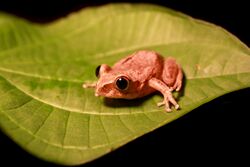Biology:Leptopelis
| Leptopelis | |
|---|---|

| |
| Leptopelis aubryi, the type species | |
| Scientific classification | |
| Domain: | Eukaryota |
| Kingdom: | Animalia |
| Phylum: | Chordata |
| Class: | Amphibia |
| Order: | Anura |
| Family: | Arthroleptidae |
| Subfamily: | Leptopelinae Laurent, 1972 |
| Genus: | Leptopelis Günther, 1859 |
| Type species | |
| Hyla aubryi Duméril, 1856
| |
| Species | |
|
54 species (see text) | |
| Synonyms[1] | |
| |
Leptopelis is a genus of frogs in the family Arthroleptidae. They are found throughout Sub-Saharan Africa,[1] excluding Madagascar.[2] It is placed in monotypic subfamily Leptopelinae,[3][4] although this subfamily is not always recognized.[2] They have a number of common names, including forest treefrogs, tree frogs, leaf-frogs,[1] and big-eyed frogs.[5]
Description
Leptopelis are mostly medium-sized frogs (snout–vent length 26–42 mm (1.0–1.7 in)), but Leptopelis palmatus can reach 87 mm (3.4 in).[4] Tympanum is present. Most species have expended digit tips.[2]
Ecology
Leptopelis are mainly arboreal, but some species, especially in more arid areas, are terrestrial or even subfossorial.[2][4] Breeding typically starts with the heavy rains in the beginning of the wet season. Eggs may be deposited either in water or in/on the ground. Development includes a free-living tadpole stage, with a possible exception of Leptopelis brevirostris, whose large eggs suggest that development could be direct.[4] Males typically call in bushes or trees a meter or more above the ground.[2]
Species
As of July 2021, there are 54 recognized species:[1]
In captivity
L. vermiculatus is found in international pet trade.[6] They are hardy frogs that adapt well to captivity, and readily consume commercially available crickets.
References
- ↑ 1.0 1.1 1.2 1.3 Frost, Darrel R. (2018). "Leptopelis Günther, 1859". Amphibian Species of the World: an Online Reference. Version 6.0. American Museum of Natural History. http://research.amnh.org/vz/herpetology/amphibia/index.php//Amphibia/Anura/Arthroleptidae/Leptopelinae/Leptopelis.
- ↑ 2.0 2.1 2.2 2.3 2.4 Blackburn, David C. (2011). "Family Arthroleptidae". AmphibiaWeb. University of California, Berkeley. http://www.amphibiaweb.org/lists/Arthroleptidae.shtml.
- ↑ Frost, Darrel R. (2018). "Leptopelinae Laurent, 1972". Amphibian Species of the World: an Online Reference. Version 6.0. American Museum of Natural History. http://research.amnh.org/vz/herpetology/amphibia/index.php//Amphibia/Anura/Arthroleptidae/Leptopelinae.
- ↑ 4.0 4.1 4.2 4.3 Vitt, Laurie J.; Caldwell, Janalee P. (2014). Herpetology: An Introductory Biology of Amphibians and Reptiles (4th ed.). Academic Press. pp. 514–515.
- ↑ "Big-eyed Frogs (Genus Leptopelis)". iNaturalist. https://www.inaturalist.org/taxa/23396-Leptopelis.
- ↑ IUCN SSC Amphibian Specialist Group (2014). "Leptopelis vermiculatus". IUCN Red List of Threatened Species 2014: e.T56284A3037319. doi:10.2305/IUCN.UK.2014-1.RLTS.T56284A3037319.en. https://www.iucnredlist.org/species/56284/3037319.
Wikidata ☰ Q1306850 entry
 |



